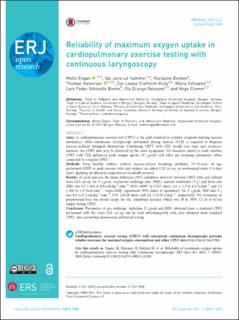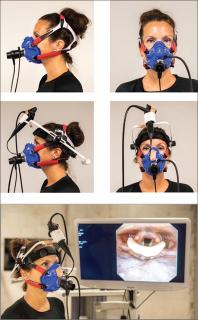| dc.contributor.author | Engan, Mette | |
| dc.contributor.author | Jansrud, Ida | |
| dc.contributor.author | Bekken, Marianne | |
| dc.contributor.author | Halvorsen, Thomas | |
| dc.contributor.author | Fretheim-Kelly, Zoe Louise | |
| dc.contributor.author | Vollsæter, Maria | |
| dc.contributor.author | Bovim, Lars Peder Vatshelle | |
| dc.contributor.author | Røksund, Ola Drange | |
| dc.contributor.author | Clemm, Hege Havstad | |
| dc.date.accessioned | 2021-03-20T03:05:59Z | |
| dc.date.available | 2021-03-20T03:05:59Z | |
| dc.date.created | 2021-01-22T16:04:04Z | |
| dc.date.issued | 2021 | |
| dc.identifier.citation | ERJ Open Research. 2021, 7(1), Artikkel 00825-2020. | en_US |
| dc.identifier.issn | 2312-0541 | |
| dc.identifier.uri | https://hdl.handle.net/11250/2734585 | |
| dc.description | This article is open access and distributed under the terms of the Creative Commons Attribution Non-Commercial Licence 4.0. | en_US |
| dc.description.abstract | Aims: A cardiopulmonary exercise test (CPET) is the gold standard to evaluate symptom-limiting exercise intolerance, while continuous laryngoscopy performed during exercise (CLE) is required to diagnose exercise-induced laryngeal obstruction. Combining CPET with CLE would save time and resources; however, the CPET data may be distorted by the extra equipment. We therefore aimed to study whether CPET with CLE influences peak oxygen uptake (V′O2peak) and other gas exchange parameters when compared to a regular CPET.
Methods: Forty healthy athletes without exercise-related breathing problems, 15–35 years of age, performed CPET to peak exercise with and without an added CLE set-up, in randomised order 2–4 days apart, applying an identical computerised treadmill protocol.
Results:At peak exercise, the mean difference (95% confidence interval) between CPET with and without extra CLE set-up for V′O2peak, respiratory exchange ratio (RER), minute ventilation (V′E) and heart rate (HR) was 0.2 (−0.4 to 0.8) mL·kg−1·min−1, 0.01(−0.007 to 0.027) units, 2.6 (−1.3 to 6.5) L·min−1 and 1.4 (−0.8 to 3.5) beats·min−1, respectively. Agreement (95% limits of agreement) for V′O2peak, RER and V′E was 0.2 (±3.7) mL·kg−1·min−1, 0.01 (±0.10) units and 2.6 (±24.0) L·min−1, respectively. No systematic or proportional bias was found except for the completed distance, which was 49 m (95% CI 16 to 82 m) longer during CPET.
Conclusion: Parameters of gas exchange, including V′O2peak and RER, obtained from a maximal CPET performed with the extra CLE set-up can be used interchangeably with data obtained from standard CPET, thus preventing unnecessary additional testing. | en_US |
| dc.language.iso | eng | en_US |
| dc.subject | laryngoscopy | en_US |
| dc.subject | respirotary | en_US |
| dc.subject | CPET | en_US |
| dc.subject | CLE | en_US |
| dc.subject | exercise | en_US |
| dc.subject | lung | en_US |
| dc.subject | clinical | en_US |
| dc.subject | VO2peak | en_US |
| dc.subject | VO2max | en_US |
| dc.subject | RER | en_US |
| dc.title | Reliability of maximum oxygen uptake in cardiopulmonary exercise testing with continuous laryngoscopy | en_US |
| dc.type | Peer reviewed | en_US |
| dc.type | Journal article | en_US |
| dc.description.version | publishedVersion | en_US |
| dc.rights.holder | © ERS 2021 | en_US |
| dc.source.pagenumber | 9 | en_US |
| dc.source.volume | 7 | en_US |
| dc.source.journal | ERJ Open Research | en_US |
| dc.source.issue | 1 | en_US |
| dc.identifier.doi | 10.1183/23120541.00825-2020 | |
| dc.identifier.cristin | 1877412 | |
| dc.description.localcode | Institutt for idrettsmedisinske fag / Department of Sports Medicine | en_US |
| dc.source.articlenumber | 00825-2020 | en_US |
| cristin.ispublished | true | |
| cristin.fulltext | original | |
| cristin.qualitycode | 1 | |


